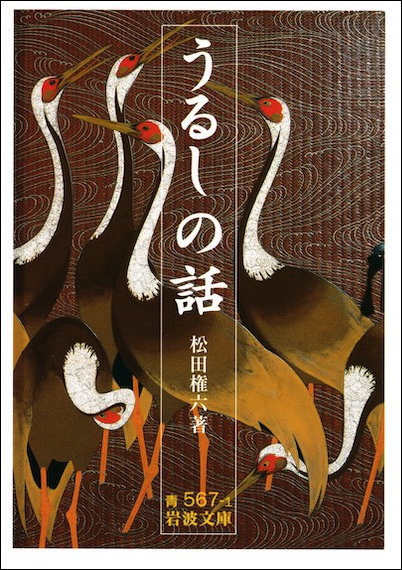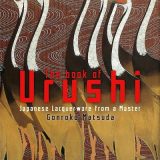If you want to find out about the art of Japanese lacquer but don’t know which book to read, I have one that I highly recommend. What is more, this Japanese book has been translated into English! In this post, I’m going to tell you about the Japanese original and why I endorse it. And in the next post, I’ll discuss the English edition.
When I was starting out as a translator in the field of Japanese arts and crafts, I took on some English translations relating to the art of lacquer. It concerned me that the field of lacquerware is completely different to that of netsuke and that there are many technical terms that I didn’t know even in Japanese, my mother tongue. Although I realized it was essential to learn more about the basis of lacquer art, I wasn’t sure I could read a book that was too technical or complicated.
I looked for a book that would give me a good grasp of Japanese lacquerware while also being easy to read. Then I came across a perfect book: Urushi no hanashi (The book of urushi), published as Iwanami Paperback Library by Iwanami Shoten in 2001. Later I learned that it is a true classic in the field of Japanese crafts and that my father had read it decades ago (the earlier version was published as Iwanami Trade Paperbacks in 1964). It immediately became one of my favorites, but I never imagined that I would become involved in its English translation in the future.
Known as the bible of urushi, this book includes the fundamentals of Japanese lacquer art, and most Japanese curators who specialize in the field have read it. Whenever I tell them that I was involved in the English translation, they are invariably amazed and say, “Really?!” They think the book is too difficult to translate into a foreign language. I, too, thought it impossible until I actually took on the task. In the words of one curator, “This book is written in the style of a general book, but the contents are just as profound as those of a specialist book.” Or to put it another way, difficult and specialized topics are written in such a way that non-specialist readers can understand them.
In addition, this book contains many fascinating anecdotes. The author, Matsuda Gonroku (1896-1986), was a master lacquer artist who specialized in maki-e (lit. sprinkled picture) and led post-WWII Japanese culture as a Living National Treasure in the maki-e technique. His autobiography in Part II of the book is indeed a saga of this legendary figure in Japanese arts and crafts. Highlights of the book are well conveyed in the following 2019 review by Akiyama Toshinori, a writer and family friend to whom I had recommended the book:
I finished reading Urushi no hanashi last weekend.
I first learned about Matsuda Gonroku from your
father, and in a word, Matsuda was an amazing
person who truly deserves respect.
Reading this book was an eye-opening experience
regarding urushi, and I read it with great interest
and pleasure. The book covers the process of
working with the urushi material, the production
process of lacquerware, various techniques, the
lacquer crafts in various regions of Japan, as well
as the use of lacquer in ships, architecture, and
on fountain pens. I was particularly fascinated by
the story of how Matsuda stood up to those who
opposed him in using lacquer for the interior
decoration of ships, eventually demonstrating how
lacquer could withstand salt water.
With the 2020 Tokyo Olympics coming up next
year, many aspects of Japanese culture will be
introduced overseas, and I felt that this book
should be read more widely, even in Japan, and
not only by those who aim to become lacquer
artists. So in this context, it is the highest honor
for you to have been involved in the translation
of such a prestigious book, and you should be
very proud of it.”
Toshinori became increasingly interested in lacquerware, particularly the maki-e technique, as can be illustrated by a quote from one of his emails in January 2023:
Thanks to this book, I have been able to look at
maki-e works with fresh eyes. Last year at the
exhibition Tokyo National Museum: Its History
and National Treasures, I took time to appreciate
appreciate not only famous pieces of lacquerware
that are illustrated in textbooks but also maki-e
items in particular.”
This book provides reliable information on tools, materials, and techniques used in the art of Japanese lacquer. I believe that the more knowledge you have of such factors, the more deeply you will understand and appreciate the actual works. This can be exemplified by a passage on the works of Rinpa school artists such as the Writing Box with the Eight-plank Bridge in Maki-e (click the following link for the image: https://bunka.nii.ac.jp/heritages/detail/456464). The distinctive nature of their work lies not only in their design. Matsuda-sensei (note: “sensei” is a Japanese honorific often used for master and teacher) points out that, in their raden (shell-inlay) works, Rinpa artists made use of a technique known as “nuritate” or “nurihanashi (also nurippanashi),” meaning “unpolished finish.” He further points out that this finish is crucial to distinguishing authentic Rinpa works from imitations, since it requires a well-equipped workshop and considerable skill. Knowing this, I think, will change the way you look at Rinpa works.
A video of Matsuda-sensei can be seen at the following link. After reading the book under discussion, one feels that his words carry even more weight and significance (unfortunately, no English subtitles are available).
https://www2.nhk.or.jp/archives/jinbutsu/detail.cgi?das_id=D0009250143_00000
One matter of concern, however, is that the author, Matsuda Gonroku, was very critical of Wajima lacquerware, though later works from Wajima have greatly improved over the years. In his commentary in Urushi no hanashi (The book of urushi), Oba Shogyo-sensei, a pupil of Matsuda-sensei and also a Living National Treasure in maki-e, mentioned that Wajima artists were inspired by Matsuda-sensei’s comments and, in recent years, have produced works of very high quality. Today Wajima lacquerware is highly regarded worldwide, and I think Matsuda-sensei would be pleased to know this in Heaven.
This book is known in the field as being a longtime best seller. It appears to be out of print at the moment and is only available in secondhand bookshops. I hope the publisher will print more copies.
Please check out the next post (click here) on “behind the scenes” of the English translation of this book!
Komada Makiko

Thank you for reading thus far, and
please do check out the next post by
clicking here!


